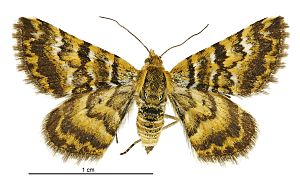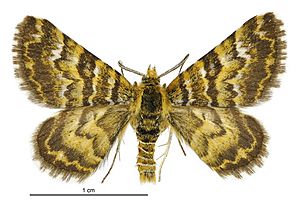Notoreas casanova facts for kids
Quick facts for kids Notoreas casanova |
|
|---|---|
 |
|
| Female | |
 |
|
| Male | |
| Conservation status | |
 Nationally Vulnerable (NZ TCS) |
|
| Scientific classification | |
| Genus: |
Notoreas
|
| Species: |
casanova
|
Notoreas casanova is a special kind of moth found only in New Zealand. It belongs to the Geometridae family, often called "looper moths" because of how their caterpillars move. This moth is quite rare and is currently listed as Nationally Vulnerable by the Department of Conservation. This means it needs our help to survive!
Contents
- Discovering the Notoreas casanova Moth
- What Does the Notoreas casanova Moth Look Like?
- Where Does the Notoreas casanova Moth Live?
- Life Cycle and Behavior of the Notoreas casanova Moth
- What Kind of Home Does the Notoreas casanova Moth Prefer?
- What Do Notoreas casanova Larvae Eat?
- Protecting the Notoreas casanova Moth
Discovering the Notoreas casanova Moth
Scientists Brian Patrick and Robert J.B. Hoare first described this moth in 2010. They gave it its scientific name. The very first specimen, called the type specimen, was found by Patrick in Southland, New Zealand. It is now kept safely at the New Zealand Arthropod Collection. The moth was named after Giacomo Casanova, a famous historical figure.
What Does the Notoreas casanova Moth Look Like?
The young N. casanova larvae (caterpillars) start out yellow-green. As they grow, their heads turn orange and their bodies become a pinkish color.
Adult N. casanova moths look a lot like their close relative, N. elegans. However, you can tell N. casanova apart because it is usually smaller. It also has a full black band on the underside of its front wings. Plus, it has a complete black line on its back wings.
Where Does the Notoreas casanova Moth Live?
This moth is endemic to New Zealand. This means it is found naturally nowhere else in the world. Populations of N. casanova have been discovered in Southland, New Zealand. You can find them at places like Fortrose Spit, Tiwai Peninsula, and Three Sisters Sand Dune. There might also be a group of them at Sandhill Point in Fiordland.
Life Cycle and Behavior of the Notoreas casanova Moth
The female moth lays her tiny yellow eggs. She places them in groups on the flowers of certain plants. Sometimes, she lays them one by one on the leaves. The eggs hatch after about 14 days. The young larvae are green-yellow at first.
These larvae spend about 87 days growing. Then, they take 12 days to get ready for the next stage. They form a loose cocoon on the ground, hidden under their host plant. The moth stays in its cocoon for about 151 days. After this long wait, it emerges as an adult moth.
N. casanova moths fly during the day. They are low flyers but move very fast. They constantly vibrate their wings. This helps them take off quickly whenever they need to.
What Kind of Home Does the Notoreas casanova Moth Prefer?
This moth likes to live in specific places. It prefers areas with coastal sand and pebbles. It also enjoys sandy dunes near the coast.
What Do Notoreas casanova Larvae Eat?
The larvae of N. casanova feed on special plants. Their host plants are two native New Zealand plants. These are Pimelea lyallii and Pimelea prostrata.
Protecting the Notoreas casanova Moth
This moth is classified as Nationally Vulnerable. This classification comes from the New Zealand Threat Classification System. Being "Nationally Vulnerable" means the moth is facing a high risk of becoming endangered in New Zealand. It needs protection to help its populations grow and survive.

